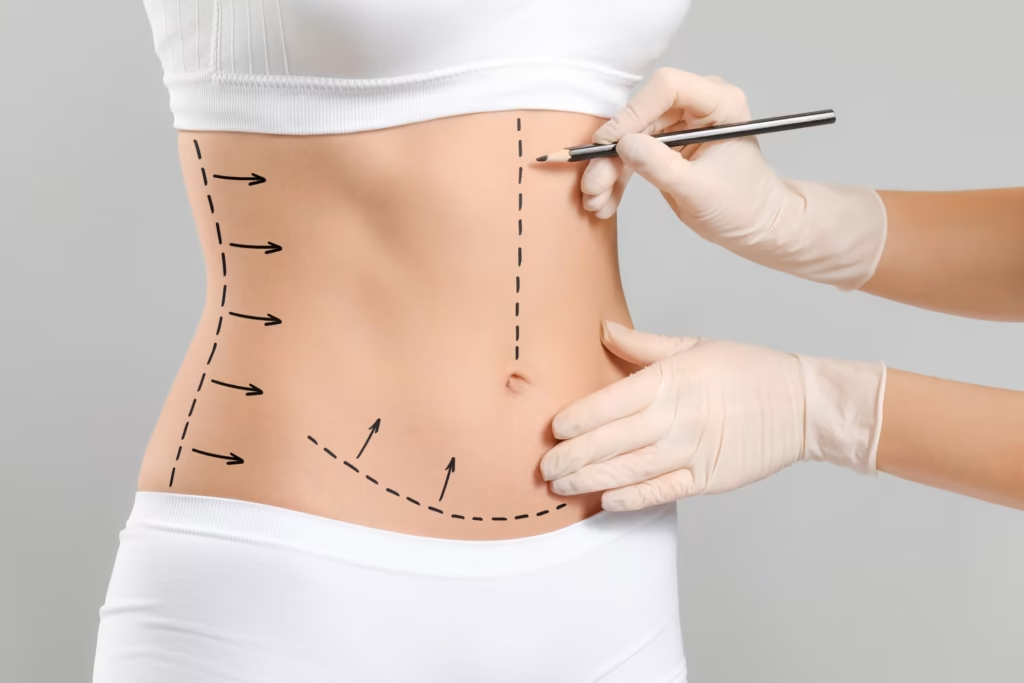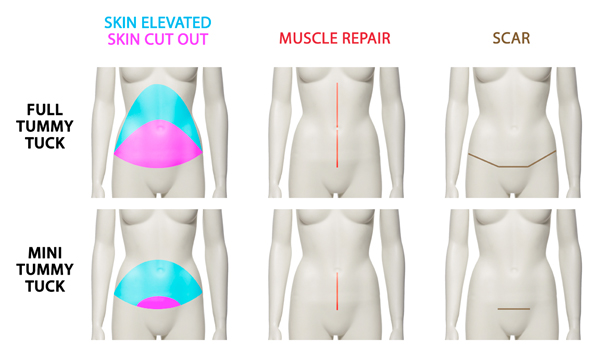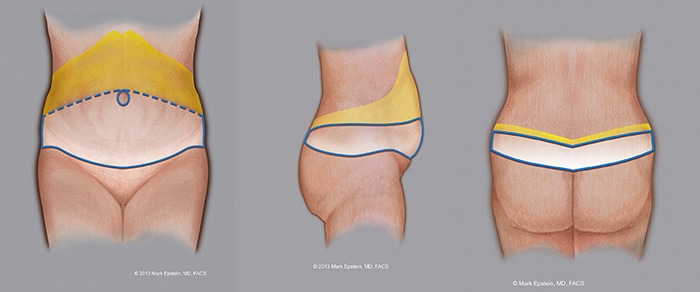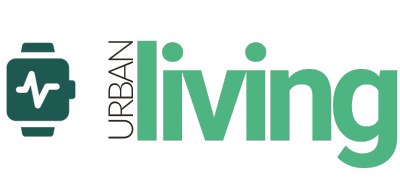Achieving a flat, toned abdomen can be challenging, especially after pregnancy, significant weight loss, or due to genetic factors.
When diet and exercise fall short of your goals, abdominoplasty, commonly known as a tummy tuck, offers a surgical solution to transform your midsection.
This comprehensive guide explores everything you need to know about getting a tummy tuck in Singapore, from understanding the procedure to navigating costs and recovery.
Related article: The Comprehensive Guide to Liposuction in Singapore
Understanding Abdominoplasty: More Than Just Fat Removal

Abdominoplasty is a sophisticated cosmetic surgical procedure that addresses multiple concerns affecting the abdominal area.
Unlike common misconceptions, a tummy tuck accomplishes far more than simple fat removal.
The procedure targets the region between your chest and pelvis, working to create a more aesthetically pleasing and functionally improved midsection.
The primary objectives of abdominoplasty include creating a flatter abdominal profile, enhancing overall contour, and restoring core muscle strength that may have been compromised due to various factors.
This surgical intervention proves particularly beneficial for individuals dealing with loose, sagging skin that cannot be addressed through traditional methods like exercise or dietary changes.
The procedure works by systematically removing excess skin and fatty tissue while simultaneously addressing weakened or separated abdominal muscles, a condition medically known as rectus diastasis.
This muscle separation commonly occurs in women following pregnancy and childbirth, as well as in individuals who have experienced massive weight loss.
By tightening these muscles and removing redundant tissue, patients can achieve a narrower waistline and improved core strength.
You might like: Fat Freezing Singapore: Cryolipolysis Treatment Guide
Exploring Different Types of Tummy Tuck Procedures
Singapore offers various abdominoplasty techniques, each designed to address specific concerns and patient needs.
Understanding these options helps ensure you choose the most appropriate approach for your individual circumstances.
Standard Full Abdominoplasty
The standard abdominoplasty represents the most comprehensive approach to abdominal contouring.
This procedure involves creating an incision that extends from one hip to the other, positioned low enough to be concealed by underwear or swimwear.
An additional incision around the belly button allows surgeons to access and reshape the entire abdominal area.
During this procedure, surgeons remove excess skin and fat from both the middle and lower abdomen while simultaneously tightening the underlying abdominal wall muscles.
The belly button is typically repositioned to create a natural appearance in its new location. This comprehensive approach delivers the most dramatic results but requires the longest recovery period.
Related article: CoolSculpting Singapore: Costs, Benefits, Risks

Mini Abdominoplasty
The mini tummy tuck, also referred to as a partial abdominoplasty, offers a less invasive alternative for patients with concerns limited to the lower abdominal area.
This technique utilizes a shorter incision, similar in length and position to a cesarean section scar, making it an excellent option for women who have previously undergone C-sections.
This approach specifically addresses sagging skin and muscle weakness below the belly button, making it ideal for patients who do not require extensive upper abdominal work.
The reduced surgical scope typically results in faster recovery times, though the extent of improvement is naturally more limited compared to a full abdominoplasty.
You might like: Non-Surgical Fat Reduction: Treatments, Benefits, and Risks
Lipo-Abdominoplasty
This innovative approach combines traditional abdominoplasty techniques with liposuction to achieve optimal results.
The integration of liposuction allows surgeons to improve contours in areas above the belly button and along the flanks, creating a more comprehensive transformation.
This combination technique proves particularly effective for patients who have both excess skin and stubborn fat deposits that do not respond to diet and exercise.
The harvested fat can sometimes be repurposed for other cosmetic enhancements, such as buttock augmentation.
Extended Abdominoplasty with Belt Lipectomy

For patients who have undergone massive weight loss, an extended tummy tuck may be necessary to address excess skin and tissue around the entire torso.
This procedure extends the standard abdominoplasty technique to include the removal of excess skin from the sides and back, creating a comprehensive body contouring solution.
While this approach results in longer scars and extended recovery periods, it provides the most dramatic transformation for patients with significant amounts of loose skin.
The procedure can also improve the appearance of the thighs and buttocks by lifting and tightening these areas.
You might be interested: Non-Invasive Body Contouring Treatments in Singapore
Reverse Abdominoplasty
This specialized technique addresses loose skin in the upper abdominal area through an incision made beneath the breasts.
The reverse tummy tuck proves ideal for patients whose primary concern involves excess skin above the belly button, often resulting from significant weight loss or genetic factors.
The Surgical Process: What to Expect
Understanding the surgical process helps patients prepare mentally and physically for their abdominoplasty procedure.
The journey begins well before the actual surgery and continues through a structured recovery period.
This might help: Best Aesthetic Clinic in Singapore
Pre-Surgical Preparation
Before surgery, patients undergo comprehensive marking while standing, allowing surgeons to identify areas requiring liposuction, excess skin removal, and muscle repair locations.
This planning phase ensures precise execution during the procedure.
Patients receive detailed pre-operative instructions, which may include obtaining medical clearance, stopping certain medications, and avoiding smoking for several weeks before surgery.
These preparations help minimize surgical risks and optimize healing outcomes.
During the Surgery
Abdominoplasty procedures are performed under general anesthesia and typically require between two to four hours to complete.
The surgical process begins with carefully planned incisions that allow access to the underlying tissues while minimizing visible scarring.
Once the incisions are made, abdominal skin and fat are carefully lifted to expose the underlying muscle structure and fascia.
Surgeons then address separated or weakened abdominal muscles by pulling them toward the center and securing them with strong, absorbable sutures that restore abdominal strength without causing long-term discomfort.
After muscle repair, excess skin and fat are removed, and the remaining skin is carefully repositioned.
The operating table may be adjusted to facilitate proper skin positioning and tension-free closure.
The belly button is repositioned to ensure a natural appearance, and multiple layers of sutures are used to close the incisions securely.
Read more: List of Aesthetic Treatments and Costs in Singapore
Post-Surgical Recovery
Recovery begins immediately after surgery, with most patients requiring an overnight hospital stay.
Depending on individual circumstances and surgical complexity, some patients may need to remain hospitalized for one to three days.
Pain management, antibiotic therapy, and blood-thinning medications may be prescribed to ensure comfortable recovery and prevent complications.
Temporary drainage tubes may be placed beneath the skin to remove excess fluids, typically remaining in place for several days.
Recovery Timeline and Expectations
The recovery process following abdominoplasty requires patience and adherence to post-operative instructions.
Understanding what to expect helps patients plan accordingly and achieve optimal results.
Immediate Post-Operative Period
During the first few days following surgery, patients should maintain an inclined position in bed to reduce tension on the incisions and minimize swelling.
This positioning also helps stabilize the skin in its new configuration and prevents scar stretching.
Compression garments play a crucial role in the recovery process, providing support to the newly contoured abdomen while reducing swelling and promoting proper healing.
These garments are typically worn continuously for up to three months following surgery.
Activity Restrictions and Gradual Return to Normal Life
Most patients can resume normal daily activities within one to two weeks following surgery, though individual recovery times may vary.
Heavy lifting, strenuous exercise, and vigorous activities should be avoided for at least four to six weeks or until cleared by the surgeon.
Walking is encouraged early in the recovery process to promote circulation and prevent blood clots.
Patients gradually increase their activity level under medical supervision, with full exercise clearance typically given around six to eight weeks post-surgery.
Long-Term Recovery Considerations
Complete healing and final results may take several months to achieve. Swelling gradually subsides over this period, revealing the true outcome of the procedure.
Scar maturation is an ongoing process that can continue for up to a year or more following surgery.
Potential Complications and Risk Management
Like any major surgical procedure, abdominoplasty carries certain risks that patients should understand before proceeding.
However, when performed by experienced surgeons in appropriate facilities, complications are relatively rare.
More serious complications such as blood clots, skin necrosis, or anesthesia-related issues are less common but possible.
Choosing a qualified, board-certified plastic surgeon and following all pre- and post-operative instructions significantly reduces the likelihood of complications.
Patients should also be aware of warning signs that require immediate medical attention, such as excessive pain, unusual discharge, prolonged swelling, or fever.
Determining Candidacy for Abdominoplasty
Not everyone is an ideal candidate for tummy tuck surgery. Several factors determine whether this procedure is appropriate and safe for individual patients.
Ideal candidates should be in good overall health with stable weight for at least twelve months prior to surgery. Significant weight fluctuations can affect surgical outcomes and increase complication risks.
Patients should also have realistic expectations about the procedure’s capabilities and limitations.
Smoking represents a significant risk factor that can impair healing and increase complication rates.
Patients who smoke are typically required to quit for several weeks before and after surgery to optimize healing outcomes.
Contraindications and Special Considerations
| Factor | Consideration |
|---|---|
| Pregnancy Plans | Surgery should be postponed until family planning is complete |
| Unstable Weight | Increased risk of complications and suboptimal results |
| Severe Obesity | Higher complication rates; weight loss may be recommended first |
| Smoking | Significantly increases infection and healing complications |
| Medical Conditions | Certain conditions may increase surgical risks |
Cost Considerations in Singapore
The cost of abdominoplasty in Singapore varies significantly based on several factors, with total expenses typically ranging from $10,000 to $30,000.
This wide range reflects the complexity and customization required for different patients and procedures.
Factors Affecting Cost
Surgery fees represent the largest component of the total cost, determined by the procedure’s complexity and the surgeon’s experience and reputation.
More extensive procedures requiring longer operative times and advanced techniques command higher fees.
Anesthesia fees depend on the procedure’s duration and complexity, as all abdominoplasty procedures require general anesthesia administered by qualified anesthesiologists.
Facility fees vary based on the chosen hospital or surgical center and the length of stay required.
Additional costs may include pre-operative medical evaluations, post-operative medications, compression garments, scar treatment products, and potential physiotherapy sessions.
These miscellaneous expenses, while smaller individually, can add up to a significant portion of the total cost.
Insurance Coverage
Abdominoplasty is typically considered a cosmetic procedure and is not covered by insurance in Singapore.
However, exceptions may exist when the procedure addresses medical conditions such as abdominal or umbilical hernias, which may qualify for partial coverage.
Patients should consult with their insurance providers and chosen surgeons to understand coverage options and payment plans that may be available.
Alternative Procedures and Treatments
While abdominoplasty offers comprehensive abdominal contouring, several alternative procedures may be appropriate depending on individual needs and circumstances.
- Panniculectomy: This procedure focuses specifically on removing excess skin and fat below the belly button without addressing muscle separation or repositioning the navel. Panniculectomy is often recommended for patients who have undergone massive weight loss and experience skin irritation or infections due to overhanging tissue.
- Liposuction: For patients primarily concerned with localized fat deposits rather than excess skin or muscle separation, liposuction may provide adequate improvement with less invasive techniques and faster recovery times. However, liposuction cannot address skin laxity or muscle weakness.
Non-Surgical Alternatives
Various non-surgical treatments, including cryolipolysis (fat freezing) and radiofrequency skin tightening, can provide modest improvements in abdominal appearance.
While these treatments involve minimal downtime, their results are generally less dramatic than surgical options.
Choosing the Right Surgeon in Singapore
Selecting a qualified surgeon is perhaps the most critical decision in the abdominoplasty journey.
In Singapore, only board-certified plastic surgeons are legally permitted to perform these procedures, providing an important safety framework.
When evaluating potential surgeons, patients should verify board certification, review before-and-after photos of previous patients, and assess the surgeon’s experience with the specific type of procedure being considered.
The surgeon’s communication style and ability to understand and address patient concerns are equally important factors.
Facility accreditation and safety records should also be considered, as should the availability of comprehensive post-operative care and support services.
Maintaining Long-Term Results
The longevity of abdominoplasty results depends largely on patient behavior and lifestyle choices following surgery.
While the procedure provides permanent removal of excess skin and fat, significant weight fluctuations can compromise outcomes.
Maintaining a stable weight through balanced nutrition and regular exercise is essential for preserving surgical results.
Pregnancy following abdominoplasty can potentially reverse some improvements, which is why surgeons typically recommend completing family planning before undergoing the procedure.
Regular follow-up appointments allow surgeons to monitor healing progress and address any concerns that may arise.
Patients should also protect their scars from sun exposure and consider professional scar treatment if desired.
Frequently Asked Questions
What is the difference between a tummy tuck and liposuction?
A tummy tuck removes excess skin and tightens abdominal muscles while also removing fat, whereas liposuction only removes fat deposits without addressing skin laxity or muscle separation.
Patients with significant loose skin or muscle weakness typically require abdominoplasty for optimal results.
How long do I need to take off work after surgery?
Most patients can return to desk work within one to two weeks following surgery, though this timeline may vary based on individual healing and job requirements.
Those with physically demanding jobs may need longer recovery periods, typically four to six weeks.
Will a tummy tuck help me lose weight?
Abdominoplasty is not a weight loss procedure but rather a body contouring surgery.
While some weight reduction occurs due to tissue removal, the primary goal is improving abdominal shape and tone rather than achieving significant weight loss.
Can I have children after a tummy tuck?
Pregnancy is possible after abdominoplasty, but it may compromise surgical results by stretching the abdominal skin and potentially causing muscle separation to recur.
Surgeons typically recommend completing family planning before undergoing the procedure.
How visible will my scars be?
Tummy tuck scars are permanent but are strategically placed to be concealed by underwear and swimwear.
Scars typically fade significantly over time and can be further improved with proper care and professional treatments if desired.
When can I start exercising again?
Light walking is encouraged within days of surgery to promote circulation, while more strenuous exercise is typically restricted for six to eight weeks.
Your surgeon will provide specific guidelines based on your healing progress and the extent of your procedure.
What happens if I gain weight after my tummy tuck?
Significant weight gain following abdominoplasty can stretch the skin and compromise results, though the improvement in muscle tone typically remains.
Maintaining a stable weight through healthy lifestyle choices is essential for preserving surgical outcomes.
Are there non-surgical alternatives to a tummy tuck?
Non-surgical treatments like cryolipolysis and radiofrequency can provide modest improvements, but they cannot address significant skin laxity or muscle separation that typically require surgical intervention for meaningful correction.
How do I choose the best surgeon for my procedure?
Look for board-certified plastic surgeons with extensive experience in abdominoplasty, review their before-and-after photos, read patient testimonials, and ensure you feel comfortable with their communication style and surgical approach during your consultation.
What should I expect during my consultation?
During your consultation, the surgeon will evaluate your anatomy, discuss your goals and expectations, explain the recommended procedure and alternatives, review risks and benefits, and provide cost information.
This is also your opportunity to ask questions and assess whether you feel confident in the surgeon’s expertise.
How long do tummy tuck results last?
The results of abdominoplasty are considered permanent, as the removed skin and fat do not return.
However, natural aging, significant weight changes, and pregnancy can affect the long-term appearance of your results.
Is the surgery very painful?
Pain levels vary among patients, but modern pain management techniques help ensure comfortable recovery.
Most patients describe the discomfort as manageable with prescribed medications, and pain typically decreases significantly within the first week following surgery.

